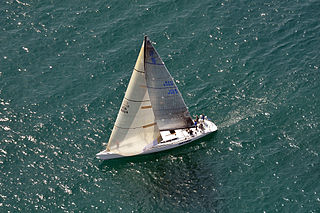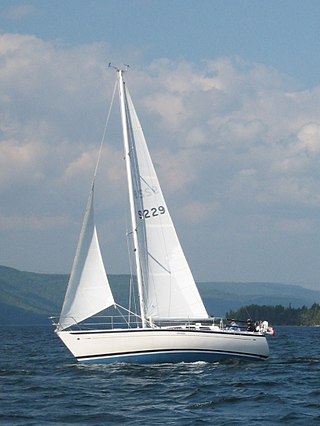
The GP14 is a wooden or fibreglass hulled double-handed fractional Bermuda rigged sailing dinghy designed by Jack Holt in 1949.

A genoa sail is a type of large jib or staysail that extends past the mast and so overlaps the main sail when viewed from the side, sometimes eliminating it. It was originally called an "overlapping jib" and later a genoa jib. It is used on single-masted sloops and twin-masted boats such as yawls and ketches. Its larger surface area increases the speed of the craft in light to moderate winds; in high wind, a smaller jib is usually substituted, and downwind a spinnaker may be used.

A Bermuda rig, Bermudian rig, or Marconi rig is a configuration of mast and rigging for a type of sailboat and is the typical configuration for most modern sailboats. This configuration was developed in Bermuda in the 17th century; the term Marconi, a reference to the inventor of the radio, Guglielmo Marconi, became associated with this configuration in the early 20th century, because the wires that stabilize the mast of a Bermuda rig reminded observers of the wires on early radio masts.

A fractional rig on a sailing vessel consists of a foresail, such as a jib or genoa sail, that does not reach all the way to the top of the mast.

The Day Sailer is a day sailer for pleasure sailing as well as racing; it is sailed throughout North America and Brazil. Designed by Uffa Fox and George O'Day in 1958, the Day Sailer possesses a 6-foot beam, an overall length of 17 feet, a fiberglass hull and a cuddy cabin. It is able to sleep two. The sloop rig includes mainsail, jib and a spinnaker on an aluminum mast and boom.
The Rhodes 19 is an American trailerable day sailer or sailing dinghy, that was designed by Philip Rhodes as a one-design racer and first built in 1958.

The 3000 is a racing sailing dinghy crewed by two persons with a trapeze for the crew. Launched in 1996 as the Laser 3000, the 3000 was developed from the Laser 2, using the original Frank Bethwaite-designed planing hull combined with a new designed self-draining deck by Derek Clark. Clark also re-designed the rig, using spars and sails from premium proprietary sources and replacing the symmetric spinnaker of the Laser 2 by a larger asymmetric spinnaker (gennaker). The gennaker is chute-launched and retrieved using a single halyard line, and is set on a retractable bowsprit. Helm balance and handling were improved using a shorter-footed mainsail with two full-width battens giving a larger roach. A mast with conventional spreaders replaced the now-unusual diamond arrangement of the Laser 2.

The Windmill is an American sailing dinghy that was designed by Clark Mills as a one-design racer and first built in 1953.
The Dabchick is a South African youth sailing dinghy that is raced two up or single-handed. A Bermuda rigged boat, it has a mainsail and jib. Its hull is very shallow and its skipper sits on its flat deck. This hard chined scow was designed by Jack Köper in 1955. Since they were published in 1956, nearly 3,500 plans have been issued to builders, and over 4,000 boats have been built. It is usually sailed by young crew with teenager skipper instead of the Optimist, before moving into higher performance classes.

The Topcat is a one-design sailing catamaran boat class which is divided into several boat sizes.
The Tempest 23 is an American trailerable sailboat designed in 1962 by Philip Rhodes and Richard D. Carlson.

The Chance 32/28 is a Canadian and French sailboat, that was designed by naval architect Britton Chance Jr. and first built in 1972.

The Bluejacket 23 is a 23-foot (7.0 m) Canadian trailerable, fibreglass monohull sailboat designed by Cuthbertson & Cassian as a day sailer and club racer and first built in 1967.

The Laser 28 is a Canadian-built sailboat designed by New Zealander Bruce Farr and first produced in 1984.
The Geary 18 is an American sailboat that was designed by Ted Geary as a one-design racer and first built in 1926.
The Hunter 38 is an American sailboat that was designed by Glenn Henderson as a cruiser and first built in 2004.
The Freedom 25 is an American sailboat that was designed by Garry Hoyt as a single-handed racer-cruiser and first built in 1980.
The Baltic 40 is a Finnish sailboat that was designed by Judel/Vrolijk & Co. as an International Offshore Rule racer-cruiser and first built in 1988.
The Dickerson 41 is an American sailboat that was designed by Ernest Tucker as a cruiser and first built in 1973.

The Hampton One-Design is an American sailing dinghy that was designed by Vincent Serio as a one-design racer and first built in 1934.











